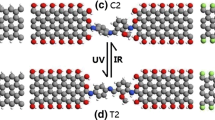Abstract
In this paper, we investigate the effects of spin-dependent electron and defect in the carbon-based molecular device. Our proposed molecular device is designed by two carbon chains, which is bonded to a defect. The defect topology includes pentagonal and octagonal carbon rings, which is put between two zigzag-edged graphene nanoribbon (ZGNR). The spin effect and switching symbiosis are shown in this carbon-based device. By switching of the orientation of the defect in two states (S1/S2 states) relative to the two electrodes, the full spin effect is shown. Also, we report the obvious negative differential resistance (NDR) behavior in our proposed molecular device. The results suggest that the proposed composition significantly affects the ratio of current and voltage, which the maximum peak of current (S2 state) is lower than 0.0022 μA and could have a potential application in the next generation of molecular circuits.





Similar content being viewed by others
References
Zeng J, Chen KQ (2013) Spin filtering, magnetic and electronic switching behaviors in manganese porphyrin-based spintronic devices. J Mater Chem C. https://doi.org/10.1039/c3tc30431k
Wan H, Zhou B, Chen X, Sun CQ, Zhou G (2012) Switching, dual spin-filtering effects, and negative differential resistance in a carbon-based molecular device. J Phys Chem C. https://doi.org/10.1021/jp2092576
Deng Y-X, Chen S-Z, Zeng Y, Zhou W-X, Chen K-Q (2017) Large spin rectifying and high-efficiency spin-filtering in superior molecular junction. Org Electron 50:184–190. https://doi.org/10.1016/J.ORGEL.2017.07.046
Filipe A, Drouhin HJ, Lampel G, Lassailly Y, Nagle J, Peretti J, Safarov VI, Schuhl A (1998) Spin-dependent transmission of electrons through the ferromagnetic metal base of a hot-electron transistorlike system. Phys Rev Lett. https://doi.org/10.1103/PhysRevLett.80.2425
Sun X-W, Zhao P (2019) Large dual spin-rectifying and high-efficiency dual spin-filtering in cyclooligomeric Mn-phthalocyanine dimer molecular junction. Chem Phys Lett 724:73–79. https://doi.org/10.1016/J.CPLETT.2019.03.056
Enamullah, Kumar V, Setlur GS (2012) Crossover of coherent rabi oscillations in graphene. Phys B Condens Matter 407(23):4600–4609. https://doi.org/10.1016/J.PHYSB.2012.08.005
Drath O, Boskovic C (2018) Switchable cobalt coordination polymers: spin crossover and valence tautomerism. Coord Chem Rev 375:256–266. https://doi.org/10.1016/J.CCR.2017.11.025
Xiao W-H, Xie F, Zhang X-J, Chu Y-F, Liu J-P, Wang H-Y, Fan Z-Q, Long M-Q, Chen K-Q (2019) Large negative differential resistance behavior in arsenene nanoribbons induced by vacant defects. Phys Lett A 383(14):1629–1635. https://doi.org/10.1016/J.PHYSLETA.2019.02.022
He J, Zheng L, Feng D, Liu M, Shao D, Lu Z, Zhang X, Wang W, Wang W, Lu F et al (2018) Interfacial effects on the microstructures and magnetoresistance of Ni80Fe20/P3HT/Fe organic spin valves. J Alloys Compd 769:991–997. https://doi.org/10.1016/J.JALLCOM.2018.08.024
Iqbal MJZ, Hussain G, Siddique S, Hussain T, Iqbal MJZ (2018) Influence of DC-biasing on the performance of graphene spin valve. Solid State Commun 272:33–36. https://doi.org/10.1016/j.ssc.2018.01.010
Svalov AV, Vas’kovskiy VO, Orue I, Kurlyandskaya GV (2017) Tailoring of switching field in GdCo-based spin valves by inserting co layer. J Magn Magn Mater 441:795–798. https://doi.org/10.1016/J.JMMM.2017.06.076
Feng M, Gao L, Deng Z, Ji W, Guo X, Du S, Shi D, Zhang D, Zhu D, Gao H (2007) Reversible, erasable, and rewritable nanorecording on an H2 rotaxane thin film. J Am Chem Soc. https://doi.org/10.1021/ja067037p
Yang J, Han X, Yuan P, Bian B, Zheng Y, Shi H, Ding Y (2018) Effect of the lateral linking groups on the switching behavior in single molecular device. Mater Chem Phys 213:140–145. https://doi.org/10.1016/J.MATCHEMPHYS.2018.04.028
Kolla HS, Surwade SP, Zhang X, MacDiarmid AG, Manohar SK (2005) Absolute molecular weight of polyaniline. J Am Chem Soc. https://doi.org/10.1021/ja055327k
Lefter C, Tan R, Dugay J, Tricard S, Molnár G, Salmon L, Carrey J, Nicolazzi W, Rotaru A, Bousseksou A (2016) Unidirectional electric field-induced spin-state switching in spin crossover based microelectronic devices. Chem Phys Lett 644:138–141. https://doi.org/10.1016/J.CPLETT.2015.11.036
Yanagi H, Ikuta K (2005) Stochastic switching of subphthalocyanine arrays triggered by scanning tunneling microscopy. Surf Sci 581(1):9–16. https://doi.org/10.1016/J.SUSC.2005.02.024
García-Iriepa C, Frutos LM (2018) Molecular switching by electron holes. Chem 4(7):1488–1489. https://doi.org/10.1016/J.CHEMPR.2018.06.010
Bian B, Yang J, Han X, Shi H, Ding Y (2018) Switching behavior induced by different substituents of group in single molecular device. Eur Phys J B 91(8):184. https://doi.org/10.1140/epjb/e2018-90269-3
Ruffieux P, Wang S, Yang B et al (2016) On-surface synthesis of graphene nanoribbons with zigzag edge topology. Nature 531:489–492. https://doi.org/10.1038/nature17151
Lahiri J, Lin Y, Bozkurt P, Oleynik II, Batzill M (2010) An extended defect in graphene as a metallic wire. Nat Nanotechnol. https://doi.org/10.1038/nnano.2010.53
Zheng G, Jia Y, Gao S, Ke S-H (2017) A planar carbon allotrope with linear bipentagon-octagon and hexagon arrangement. Phys E Low-Dimens Syst Nanostruct 87:107–111. https://doi.org/10.1016/J.PHYSE.2016.09.011
Ren Y, Chen KQ (2010) Effects of symmetry and stone-wales defect on spin-dependent electronic transport in zigzag graphene nanoribbons. J Appl Phys. https://doi.org/10.1063/1.3309775
Ozaki T, Nishio K, Weng H, Kino H (2010) Dual spin filter effect in a zigzag graphene nanoribbon. Phys Rev B-Condens Matter Mater Phys. https://doi.org/10.1103/PhysRevB.81.075422
Papaconstantopoulos DA, Mehl MJ (2003) The Slater-Koster tight-binding method: a computationally efficient and accurate approach. J Phys Condens Matter. https://doi.org/10.1088/0953-8984/15/10/201
Li XF, Chen KQ, Wang L, Long MQ, Zou BS, Shuai Z (2007) Effect of length and size of heterojunction on the transport properties of carbon-nanotube devices. Appl Phys Lett. https://doi.org/10.1063/1.2790839
Author information
Authors and Affiliations
Corresponding author
Additional information
Publisher’s note
Springer Nature remains neutral with regard to jurisdictional claims in published maps and institutional affiliations.
Rights and permissions
About this article
Cite this article
Beyramienanlou, H., Vahed, H. A robust effect of the defect on the switching behavior in carbon-based molecular device. J Mol Model 26, 223 (2020). https://doi.org/10.1007/s00894-020-04491-5
Received:
Accepted:
Published:
DOI: https://doi.org/10.1007/s00894-020-04491-5




